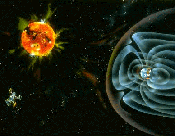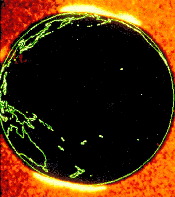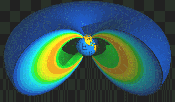 Look out star warriors and trekkers, Earth has its own protective force field -- the magnetosphere. Our planet's magnetic field extends tens of thousands of miles into space where it deflects the solar wind and other particle radiation away from Earth. The gusty solar wind and CMEs buffet and distort Earth's magnetosphere, sometimes causing magnetic storms. Fortunately, our magnetic cocoon and atmosphere shelter us from the explosions of energy from the Sun. |
![The Auroral Corona [Jan Curtis]](e1sm.gif) Auroras occur when high-energy electrons from the magnetosphere are guided by Earth's magnetic field toward the polar regions and the atmosphere. There, they collide with oxygen and nitrogen, electrically exciting these gases so that they emit light, much like the glow of a fluorescent lamp.
|
  Magnetic storms occur when a CME hits Earth's magnetosphere. Magnetic storms... + Generate million amp electric currents that distort the magnetosphere and flow down into our upper atmosphere + Disturb the Van Allen radiation belts, which become filled with "killer electrons" that can pierce the skin of a satellite and the cells of an astronaut + Cause spectacular, widespread auroras, even at low latitudes + Damage power systems on Earth and interfere with broadcasting  |
||
 From the ground, the aurora looks like curtains of light. But photographs from space show us that the aurora is shaped like a giant, oval ring. Actually, two rings: there's a crown of light around each of Earth's magnetic poles. |
Most of the high-energy, electrically-charged particles in
Earth's atmosphere are trapped in two doughnut-shaped belts surrounding
Earth: the Van Allen radiation belts. These belts of dangerous particles were the first major discovery of
the Space Age. |
Next: How on Earth Do Solar Storms Affect Us?
Back: From Stonehenge to Satellites
Front Page
Web Development: Theresa Valentine
Last Modified: 1/20/2000 TMV
